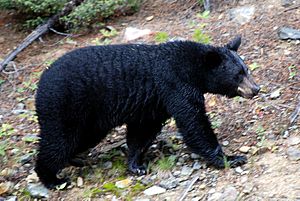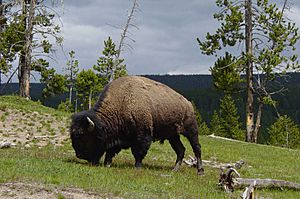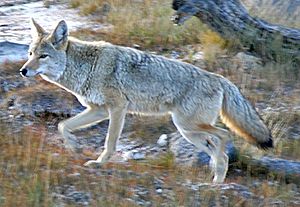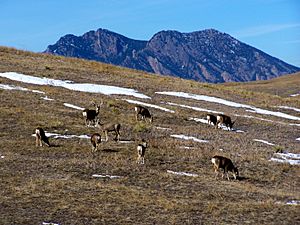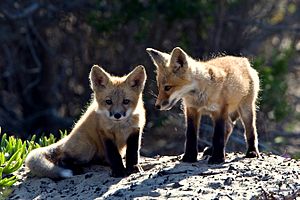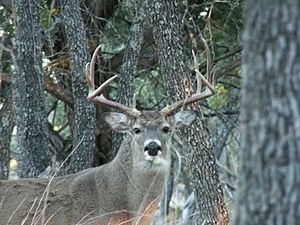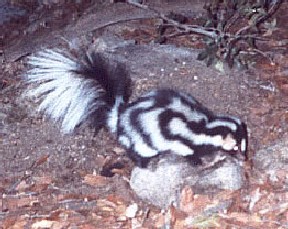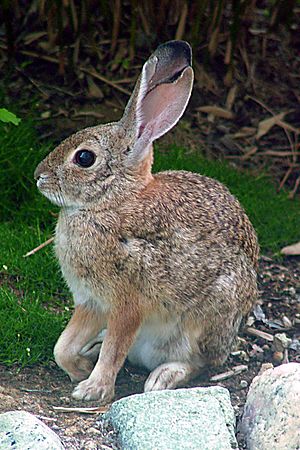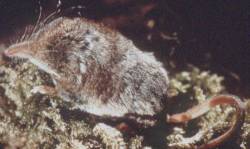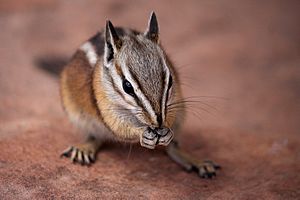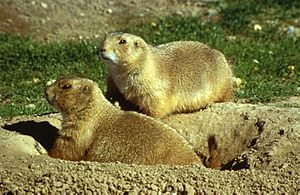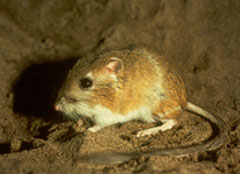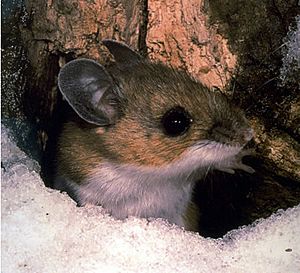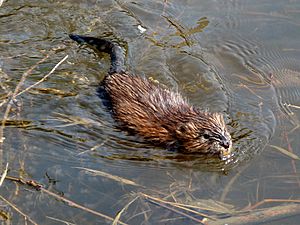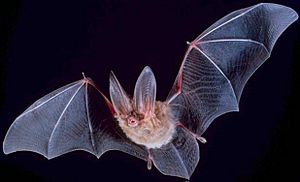List of mammals of Wyoming facts for kids
Wyoming is home to many amazing animals! You can find at least 18 different kinds of large mammals and 103 kinds of small mammals here. This list will tell you about some of them, using their common names and their scientific names.
Large and Medium-Sized Mammals
Grizzly Bear
Grizzly bears are very large and powerful bears. They are part of the Carnivora order, which means they are meat-eaters, and belong to the Ursidae family, which includes all bears.
Black Bear
Black bears are the smallest and most common type of bear in North America. They can live in many different places and eat a wide variety of foods. Black bears are found in forests, open areas, and high mountain meadows. There are lots of black bears around, so they are not considered an endangered species.
Bighorn Sheep
Bighorn sheep are known for their huge, curved horns. These horns can weigh up to 30 pounds (about 13.6 kg)! The sheep themselves can weigh up to 300 pounds (about 136 kg). You can usually spot bighorn sheep in open, mountainous areas.
American Bison
The American bison, also called the American buffalo, is a huge animal. Long ago, massive herds of bison roamed the grasslands of North America. Today, their numbers are much smaller, and they travel in smaller groups. In 1985, the American bison became the official state mammal of Wyoming! You can find them in parklands and prairies on the east side of the state.
Bobcat
The bobcat is a wild cat found in North America. It lives from southern Canada all the way to northern Mexico. Bobcats are very good at adapting to different places. They live in wooded areas, deserts, swamps, and even near cities. Their populations are healthy in most areas.
Coyote
Coyotes are wild dogs that live across North and Central America. They are sometimes called American jackals or prairie wolves. Coyotes can be found in forests and grasslands.
Elk
Elk, also known as wapiti, are some of the largest deer in the world. Only the moose is bigger in North America. Elk live in forests and at the edges of forests, where they eat grasses, plants, leaves, and tree bark. You can find them in open forests, meadows, and fields.
Gray Fox
The gray fox lives in the southern half of North America, from Canada down to parts of South America. They can be found in many different habitats, like forests, grasslands, and even near farms.
Gray Wolf
The gray wolf is the largest wild member of the dog family. Wolves have been around for a very long time, since the Ice Age! Scientists believe that domestic dogs share a common ancestor with gray wolves. Gray wolves are usually top predators in their environments, meaning they are at the top of the food chain. They often live in coniferous forests.
Canada Lynx
The Canada lynx is a wild cat found across Canada and parts of Alaska and the northern United States. It is closely related to the Eurasian lynx. Canada lynx prefer to live in coniferous forests.
Moose
Moose are the largest animals in the deer family. Male moose have huge, flat antlers that look like paddles. Moose live in northern forests and wetlands, like around lakes, slow streams, and marshy areas.
Mountain Goat
Mountain goats are large, hoofed mammals found only in North America. Even though they are called "goats," they are not true goats. They live high up in the mountains and are amazing climbers. They often rest on rocky cliffs where other animals can't reach them. You can find them on high peaks and in meadows.
Mountain Lion
Mountain lions are also known as cougars, pumas, or panthers. They are large, solitary cats that live across North and South America. They can be found in almost every type of habitat in the Americas, from Canada to the Andes mountains. Mountain lions are the second heaviest cats in the Americas, after the jaguar. They live in coniferous forests.
Mule Deer
Mule deer live in the western part of North America. They get their name from their large, mule-like ears. Male mule deer are called bucks, females are called does, and babies are called fawns. Mule deer have a black-tipped tail, which helps tell them apart from white-tailed deer. They prefer open forests and meadows, often at high elevations.
Pronghorn
The pronghorn is a unique mammal native to western and central North America. Even though it looks like an antelope, it's not a true antelope. It's the only living member of its animal family! Pronghorn are very fast runners and live in grasslands and shrublands.
Red Fox
The red fox is a small wild dog found across North America, Europe, Asia, and northern Africa. It's the most well-known type of fox. Red foxes usually have reddish-brown fur, but some are gray, called "silver" foxes. They are very common and can live in almost any habitat, from marshes to high mountains. You can find them in grasslands and open forests.
Swift Fox
The swift fox is a small, light orange-tan fox, about the size of a house cat. They live in the western grasslands and deserts of North America. Swift foxes were once thought to be extinct in Canada, but successful programs have brought them back. They are not considered endangered because their populations are stable in other areas.
White-tailed Deer
The white-tailed deer is a medium-sized deer found across the United States, Canada, Mexico, and Central and South America. They are most common east of the Rocky Mountains. You can find them in coniferous forests, meadows, and along rivers.
Small Mammals
Procyonids
These small mammals are part of the Carnivora order.
- Ringtail, Bassariscus astutus
- Raccoon, Procyon lotor, often found in open forests and along streams.
Badgers and Weasels
These animals belong to the Mustelidae family.
- Wolverine, Gulo gulo, lives in coniferous forests and high mountain meadows.
- North American river otter, Lontra canadensis, found in rivers, lakes, and ponds.
- Pacific marten, Martes caurina, lives in coniferous forests.
- Black-footed ferret, Mustela nigripes
- Least weasel, Mustela nivalis, found in open forests and grasslands.
- American ermine, Mustela richardsonii, lives in coniferous forests and meadows.
- Long-tailed weasel, Neogale frenata, found in open forests and meadows.
- American mink, Neogale vison, lives near creeks and lakes.
- Fisher, Pekania pennanti, found in coniferous forests.
- American badger, Taxidea taxus, lives in grasslands.
Skunks
Skunks are known for their strong smell! They are part of the Mephitidae family.
- Striped skunk, Mephitis mephitis, found in open forests and grasslands.
- Western spotted skunk, Spilogale gracilis
- Eastern spotted skunk, Spilogale putorius
Hares and Rabbits
These animals are part of the Leporidae family.
- Pygmy rabbit, Brachylagus idahoensis
- Snowshoe hare, Lepus americanus, lives in coniferous forests.
- Black-tailed jackrabbit, Lepus californicus
- White-tailed jackrabbit, Lepus townsendii, found in grasslands.
- Desert cottontail, Sylvilagus audubonii
- Eastern cottontail, Sylvilagus floridanus
- Mountain cottontail, Sylvilagus nuttallii, lives in forests and brushy areas.
Pikas
Pikas are small, furry mammals that live in rocky areas.
- American pika, Ochotona princeps, found on rocky slopes.
Shrews
Shrews are tiny, mouse-like mammals with long snouts.
- Masked shrew, Sorex cinereus, lives in coniferous forests, meadows, and near ponds and streams.
- Hayden's shrew, Sorex haydeni
- Pygmy shrew, Sorex hoyi, found in dry, open coniferous forests.
- Merriam's shrew, Sorex merriami
- Dusky shrew, Sorex monticolus, lives in higher elevation coniferous forests.
- Dwarf shrew, Sorex nanus
- American water shrew, Sorex palustris, found along stream edges.
- Preble's shrew, Sorex preblei
- Vagrant shrew, Sorex vagrans, lives in moist forests, grasslands, marshes, and along streams.
Beaver
Beavers are known for building dams and lodges in the water.
- Beaver, Castor canadensis, lives in ponds, streams, and lakes.
Squirrels
This group includes many different types of squirrels, chipmunks, and marmots.
- White-tailed prairie dog, Cynomys leucurus
- Black-tailed prairie dog, Cynomys ludovicianus
- Northern flying squirrel, Glaucomys sabrinus, lives in coniferous forests and is active at night.
- Yellow-bellied marmot, Marmota flaviventris, found in open, rocky foothills.
- Abert's squirrel, Sciurus aberti
- Eastern fox squirrel, Sciurus niger
- Uinta ground squirrel, Spermophilus armatus
- Wyoming ground squirrel, Spermophilus elegans
- Golden-mantled ground squirrel, Spermophilus lateralis, lives in high, open forests and rocky areas.
- Spotted ground squirrel, Spermophilus spilosoma
- Thirteen-lined ground squirrel, Spermophilus tridecemlineatus, found in grasslands.
- Yellow-pine chipmunk, Tamias amoenus, lives in open forests, brushy, and rocky areas.
- Cliff chipmunk, Tamias dorsalis
- Least chipmunk, Tamias minimus, found in high, open forests, brushy, rocky areas, and alpine meadows.
- Uinta chipmunk, Tamias umbrinus
- American red squirrel, Tamiasciurus hudsonicus
Pocket Mice and Kangaroo Rats
These small rodents are known for their cheek pouches, which they use to carry food.
- Plains pocket mouse, Perognathus flavescens
- Great Basin pocket mouse, Perognathus parvus
- Hispid pocket mouse, Chaetodipus hispidus
- Olive-backed pocket mouse, Perognathus fasciatus
- Ord's kangaroo rat, Dipodomys ordii
- Silky pocket mouse, Perognathus flavus
Pocket Gophers
Pocket gophers are burrowing rodents that dig tunnels underground.
- Northern pocket gopher, Thomomys talpoides, lives in meadows.
- Idaho pocket gopher, Thomomys idahoensis
- Wyoming pocket gopher, Thomomys clusius
- Plains pocket gopher, Geomys bursarius
Mice
This group includes many common types of mice.
- Western deer mouse, Peromyscus sonoriensis, found in forests, grasslands, and alpine meadows.
- Northern grasshopper mouse, Onychomys leucogaster
- Western harvest mouse, Reithrodontomys megalotis
- Plains harvest mouse, Reithrodontomys montanus
- White-footed mouse, Peromyscus leucopus
- Pinyon mouse, Peromyscus truei
- Canyon mouse, Peromyscus crinitus
Jumping Mice
Jumping mice are known for their long tails and ability to jump.
- Western jumping mouse, Zapus princeps, lives in grasslands and alpine meadows.
- Meadow jumping mouse, Zapus hudsonius
Muskrats, Voles and Woodrats
This group includes animals that live near water or in rocky areas.
- Muskrat, Ondatra zibethicus, lives in streams, lakes, and marshy areas.
- Heather vole, Phenacomys intermedius, found in coniferous forests and alpine meadows.
- Long-tailed vole, Microtus longicaudus, lives in coniferous forests and grasslands.
- Meadow vole, Microtus pennsylvanicus, found in open forests, meadows, and along streams and marshy areas.
- Southern red-backed vole, Clethrionomys gapperi, lives in coniferous forests.
- Water vole, Microtus richardsoni, found at high elevation stream and lake edges.
- Montane vole, Microtus montanus
- Prairie vole, Microtus ochrogaster
- Sagebrush vole, Lemmiscus curtatus
- Bushy-tailed woodrat, Neotoma cinerea, lives in rocky areas and old buildings.
Porcupines
Porcupines are known for their sharp quills that protect them from predators.
- North American porcupine, Erethizon dorsatum, lives in coniferous forests.
Bats
Bats are the only mammals that can truly fly! Most bats are active at night.
- Big brown bat, Eptesicus fuscus, lives in coniferous forests, often around buildings and caves.
- Hoary bat, Lasiurus cinereus, found in coniferous forests, mostly active at night.
- Little brown bat, Myotis lucifugus, lives in coniferous forests, often around buildings and caves, active at night.
- Long-eared myotis, Myotis evotis, found in coniferous forests and meadows, active at night.
- Long-legged bat, Myotis volans, lives in coniferous forests and meadows, active at night.
- Silver-haired bat, Lasionycteris noctivagans, found in coniferous forests and meadows, active at night.
- California myotis, Myotis californicus
- Eastern red bat, Lasiurus borealis
- Fringed myotis, Myotis thysanodes
- Northern myotis, Myotis septentrionalis
- Pallid bat, Antrozous pallidus
- Spotted bat, Euderma maculatum
- Townsend's big-eared bat, Corynorhinus townsendii
- Western small-footed myotis, Myotis ciliolabrum
- Yuma myotis, Myotis yumanensis
- Eastern pipistrelle, Pipistrellus subflavus
- Brazilian free-tailed bat, Tadarida brasiliensis
- Big free-tailed bat, Nyctinomops macrotis
Exotic Species (Not Native to Wyoming)
These mammals were brought to Wyoming by people and are not naturally found here.
- Eastern gray squirrel, Sciurus carolinensis
- Virginia opossum, Didelphis virginiana
- House mouse, Mus musculus
- Norway rat, Rattus norvegicus


